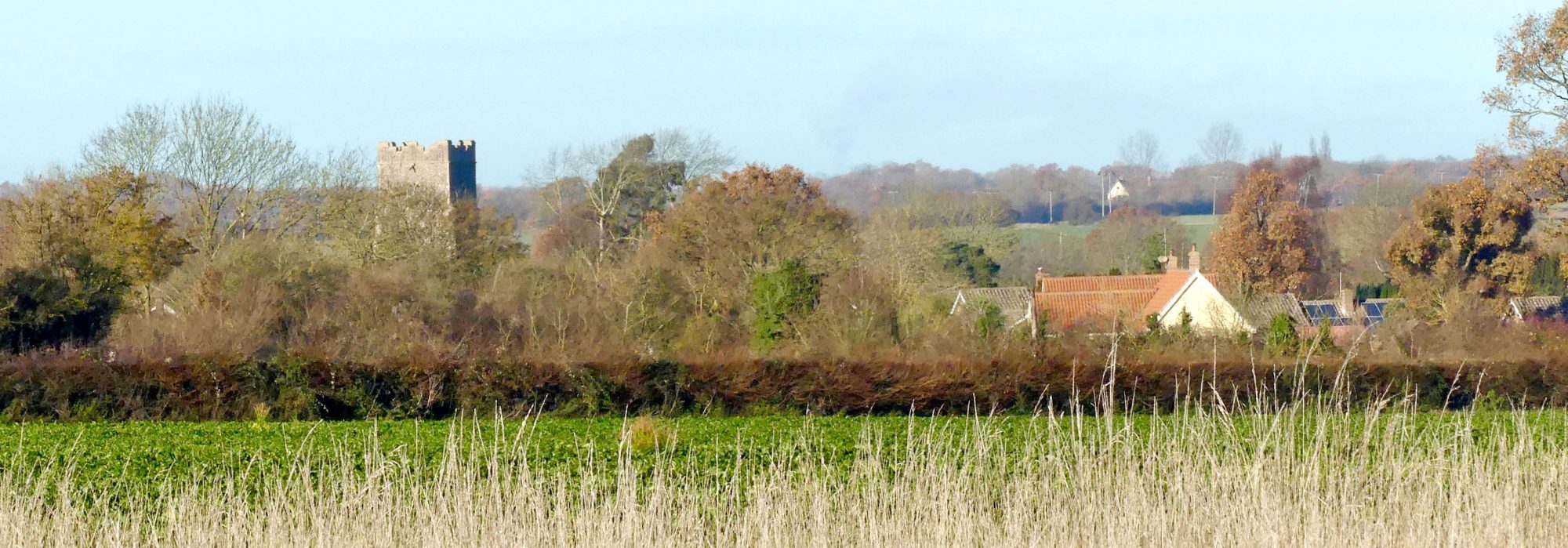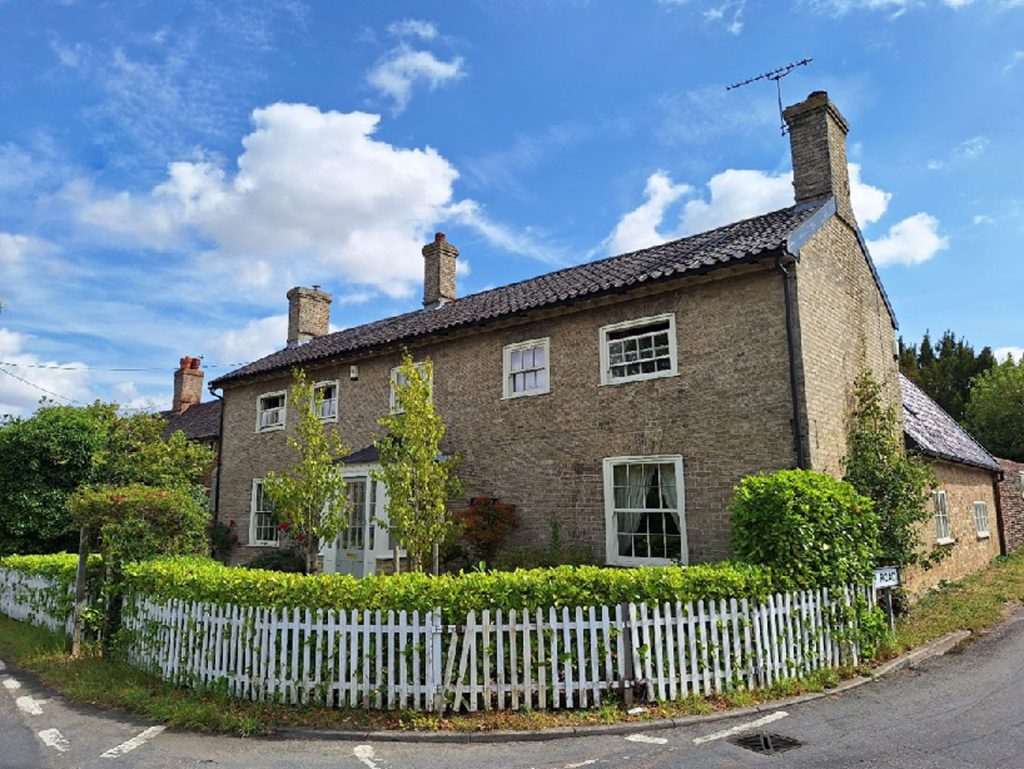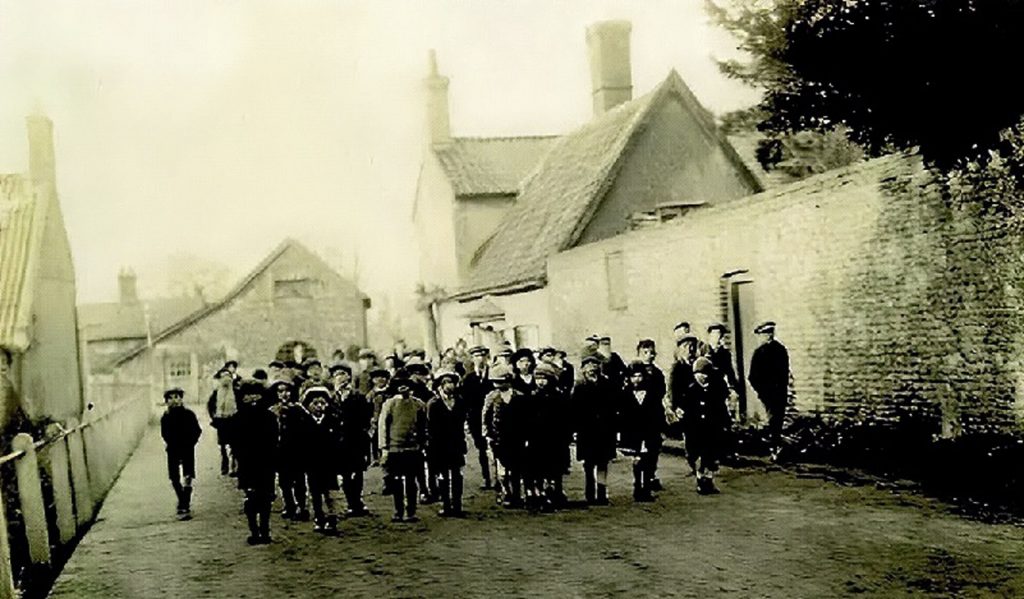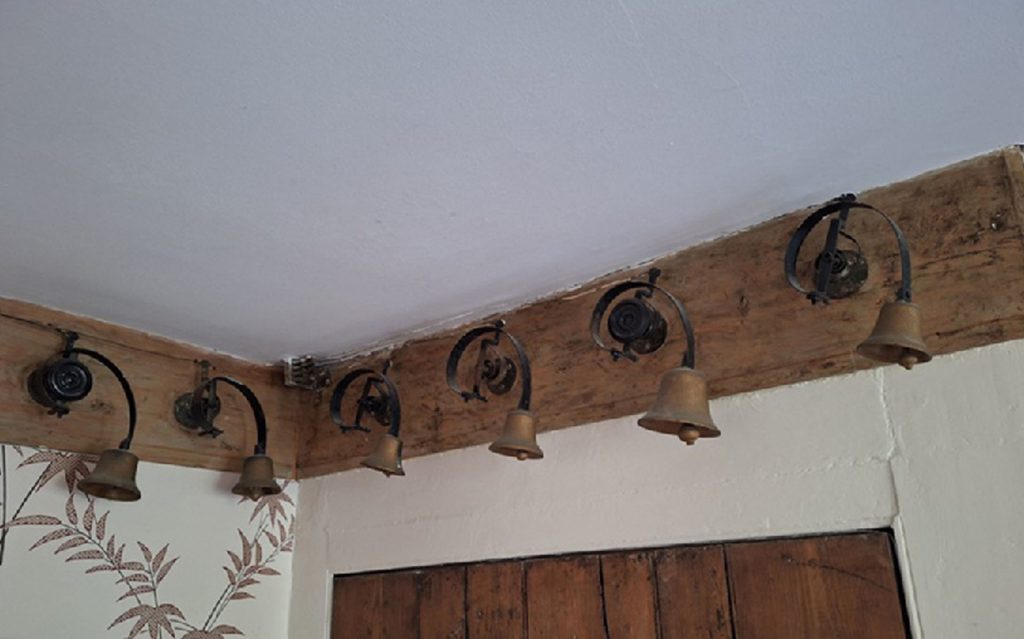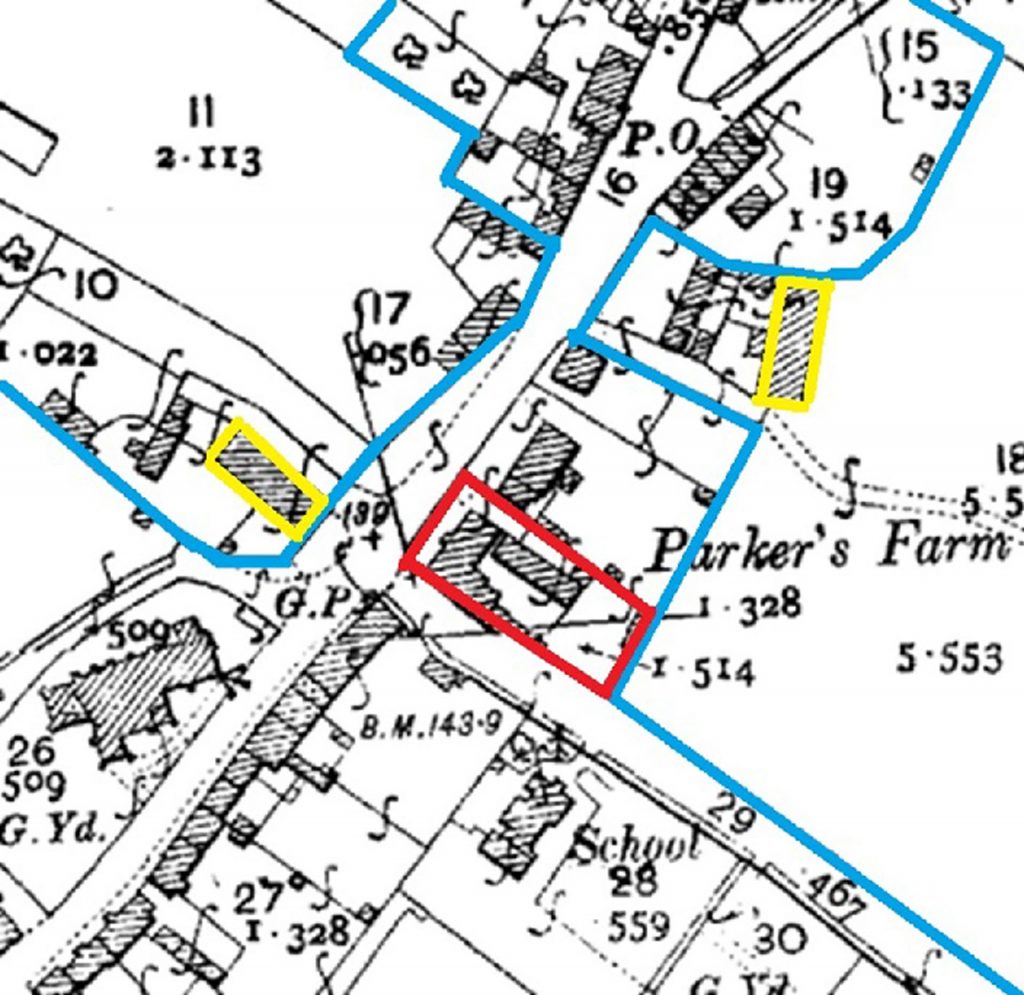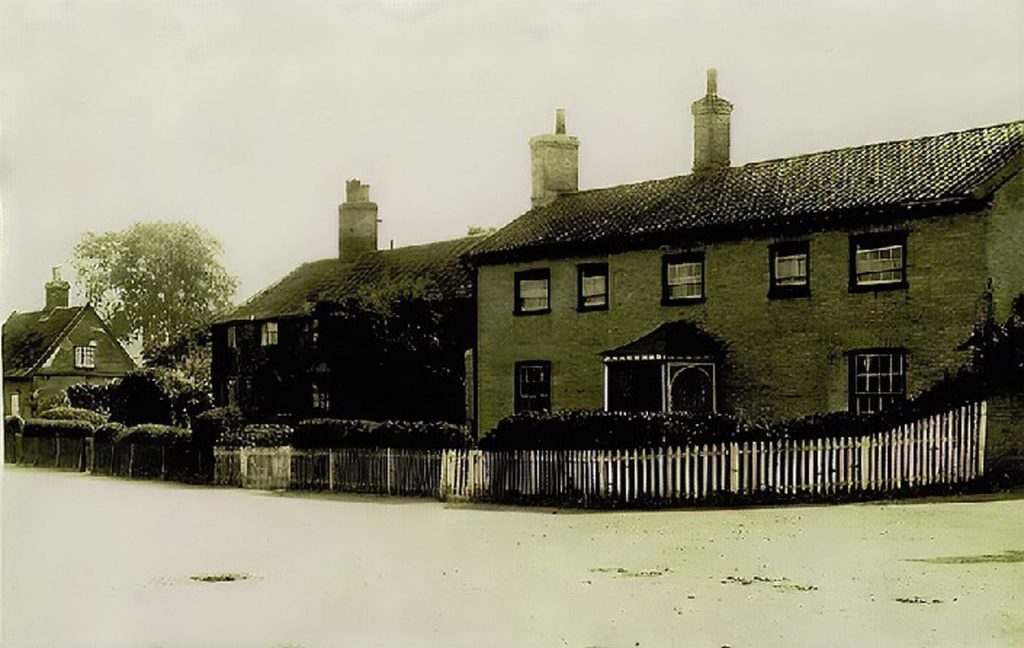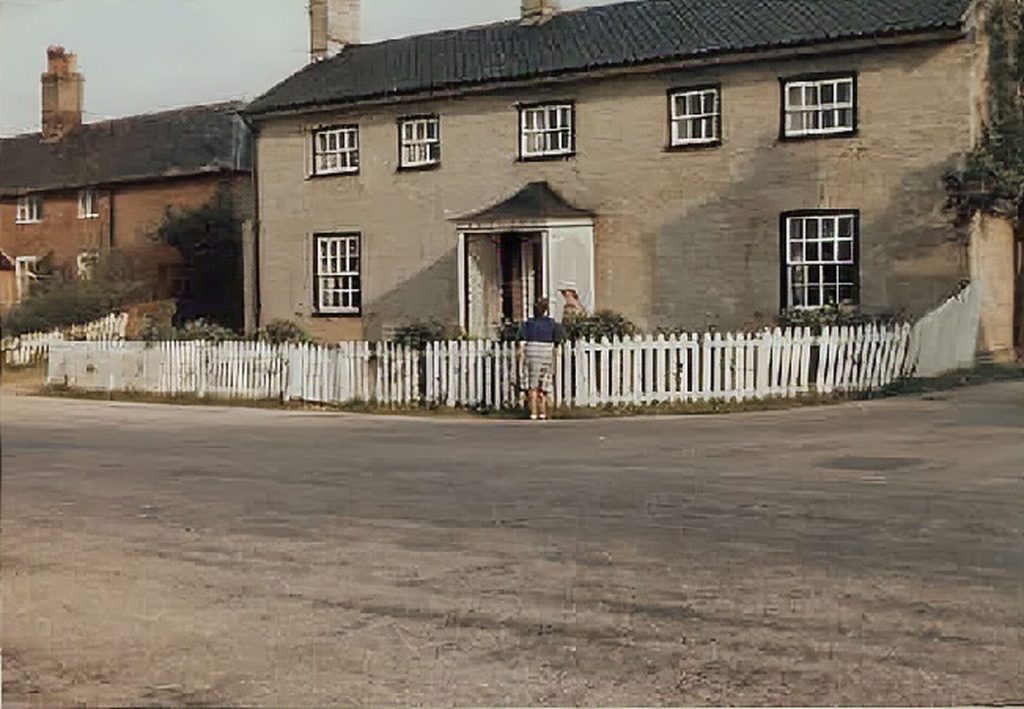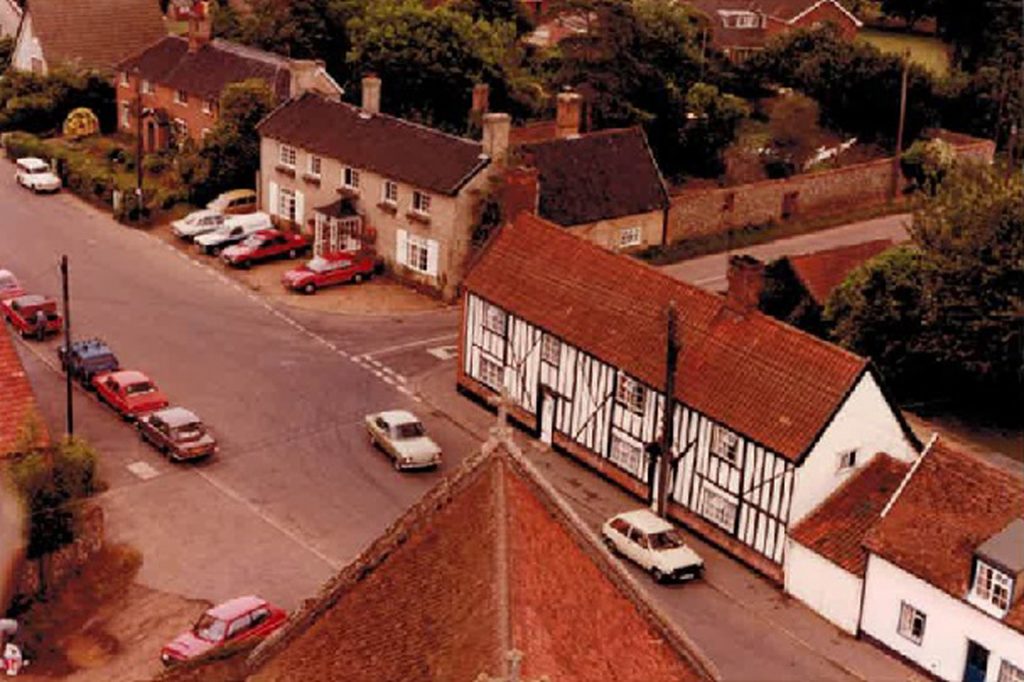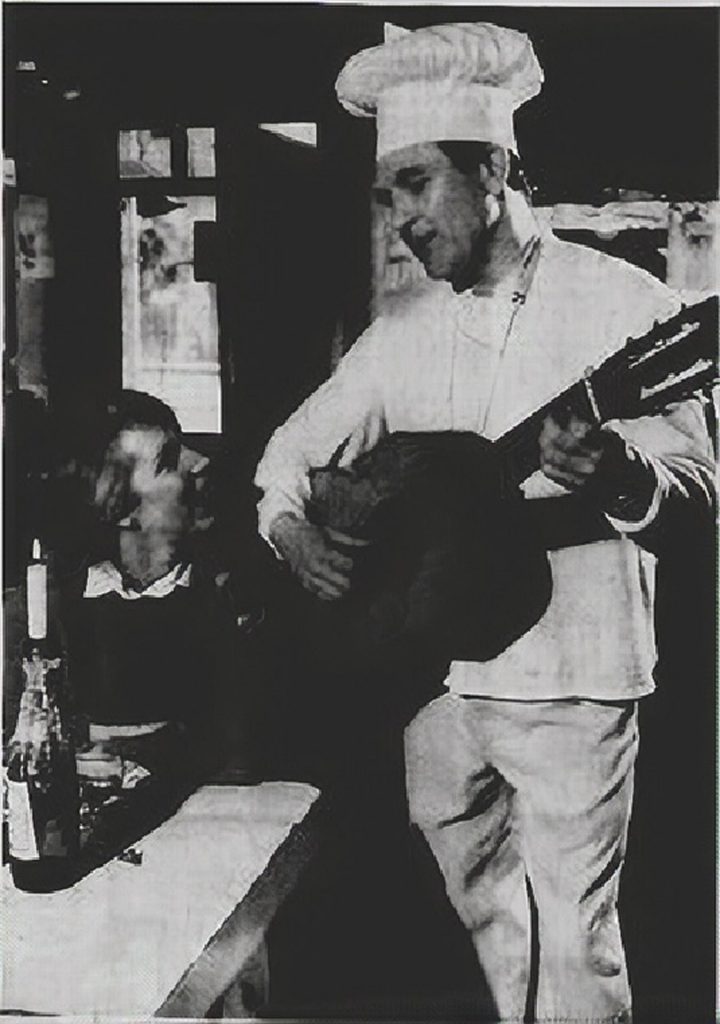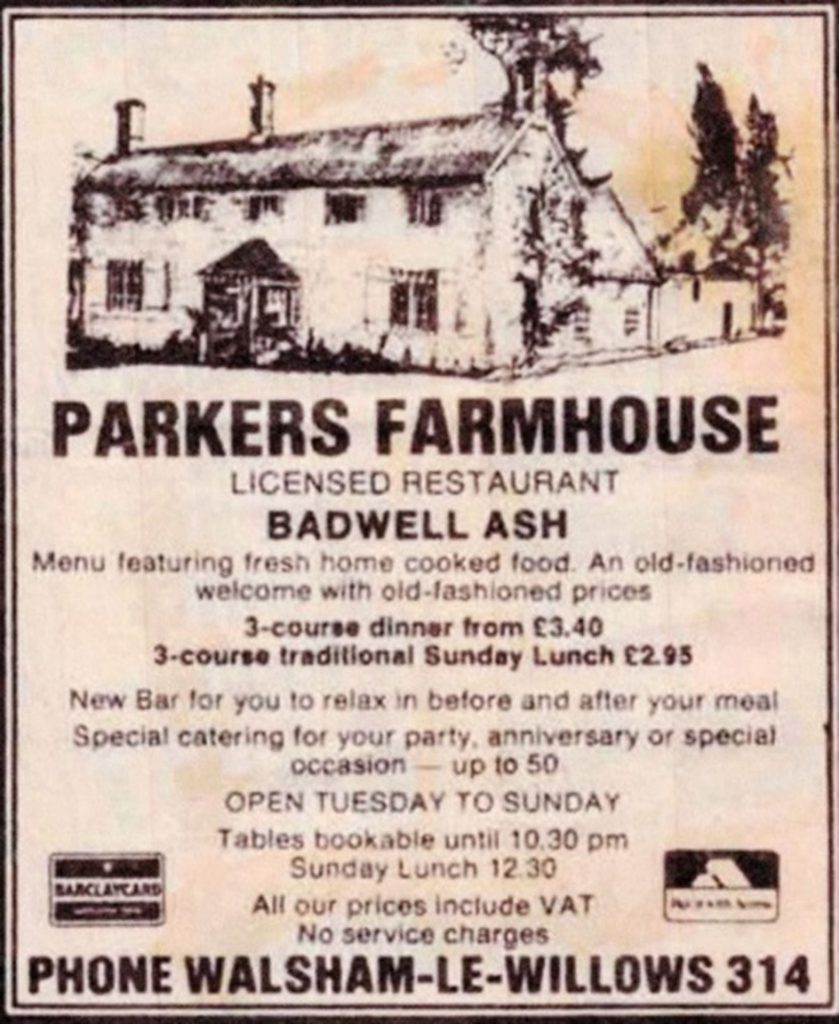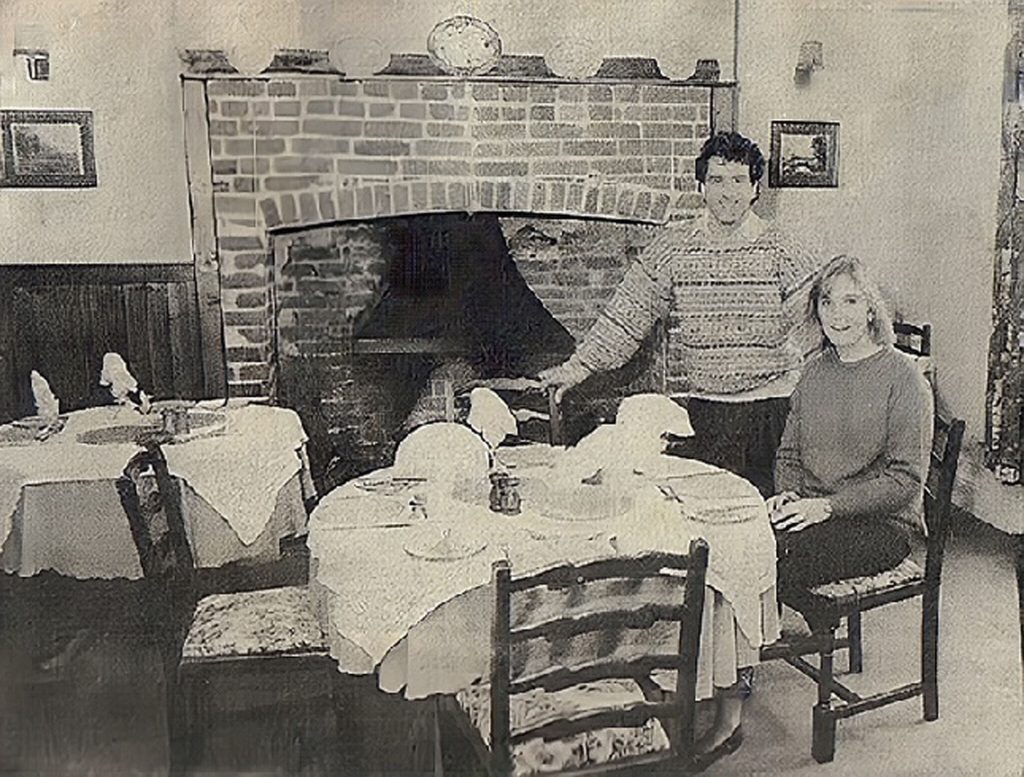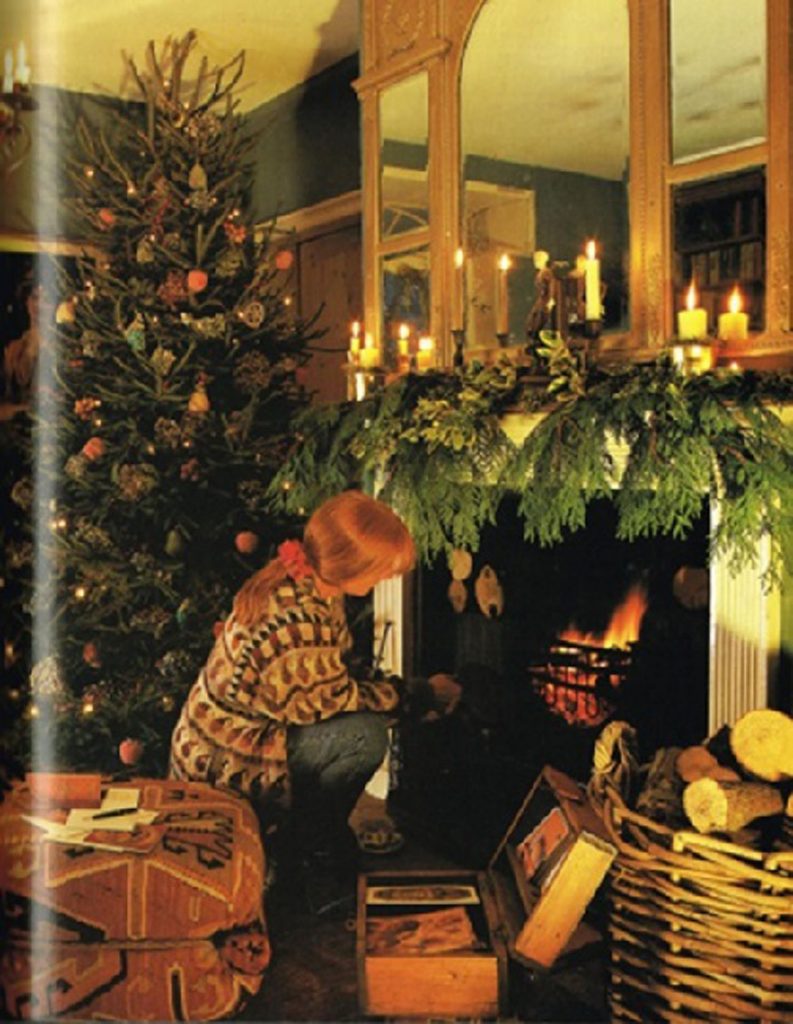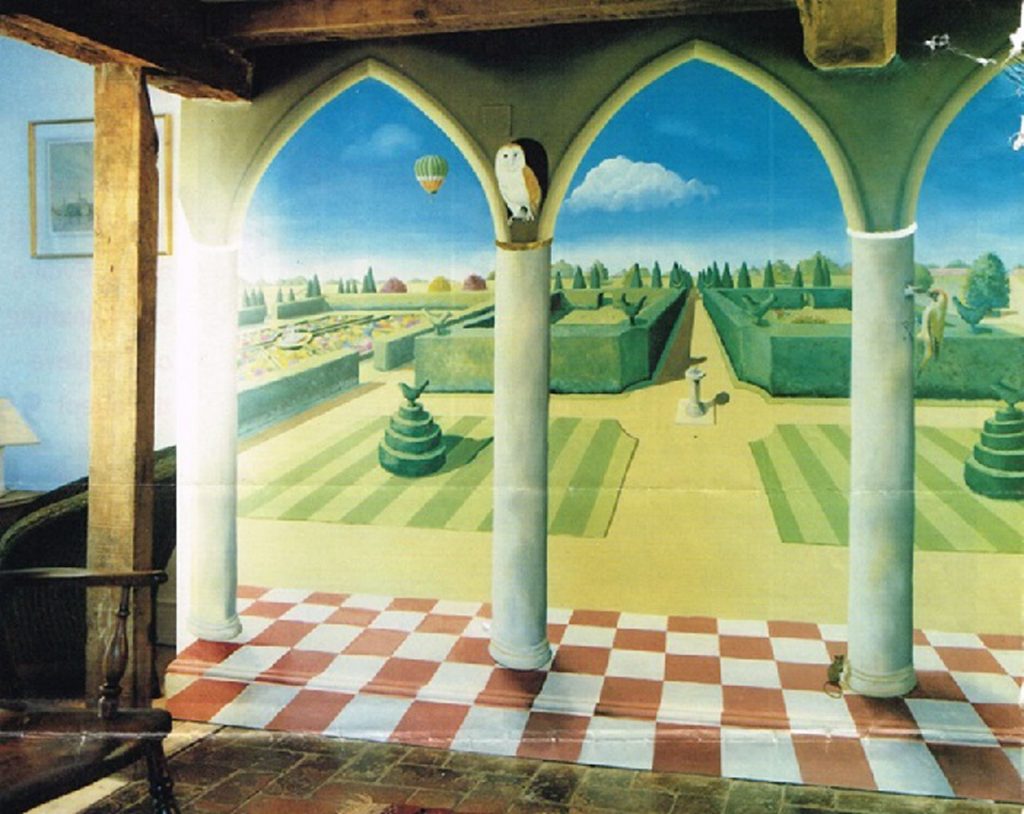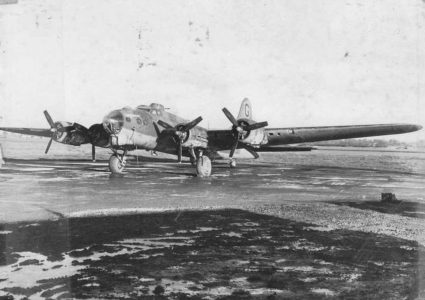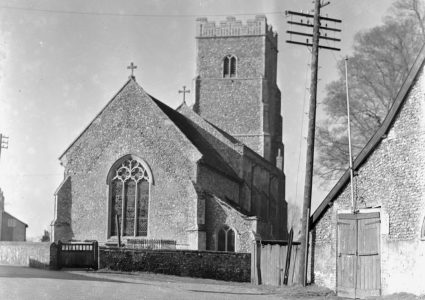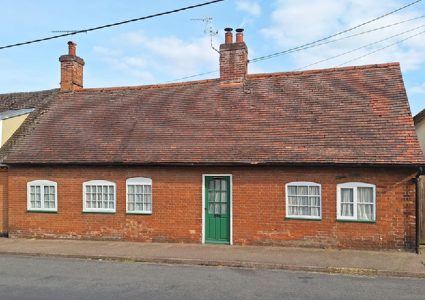Before Parkers Farmhouse was built
It is difficult to establish what was here before Parkers Farmhouse existed simply because the house is named today after the person who built the house in the late C18. However, by looking through a number of Indentures and Deeds held at The Suffolk Archive we believe we have established that a Thomas Quantrill of Walsham-le-Willows (1731-1797) was the former Copyholder or owner of the site that comprised a number of dwellings and a blacksmith’s shop. After Thomas Quantrill’s death in 1797, his son William Quanterell or Quantrill became the Copyholder and on his death in 1804, the Copyhold was transferred to Philip Parker.
It was recorded by a Deed in 1817 and an Abstract of Title dated 1844 that Philip Parker took a Surrender of Lands in 1804 from the Executors of William Quanterell, of:
“….all that messuage lately erected upon the site of a tenement and blacksmith’s shop and a little orchard….one rood with the yards, gardens, outhouses and buildings and appurtenances …… whereas abuts The Street towards the North and lies next the way leading from Badwell to Wyverstone.
This description is patently the site at the corner of The Street and Richer Road. The Abstract goes on to describe that apart from the blacksmith’s shop the “tenement” comprised
….” four dwellings, cottages, yards, gardens and outhouses ….. and are now in the occupation of Albert Allen and Robert Mullinger…in the 9th year of the reign of George III” (1804)
It therefore seems likely that Philip Parker demolished the blacksmith’s shop and one or more of the “four dwellings” to construct the Georgian section of Parkers farmhouse that fronts “The Street towards the North” but retained one of the dwellings that fronted “the way leading from Badwell to Wyverstone” i.e. Richer Road which is the C16 section of the house.
Copyhold was a form of tenure that existed throughout the post-medieval period until 1922 when the Law of Property Act 1922 finally abolished it. Before 1922, Copyhold, which was a form of leasehold, was extremely common, but with the Lord of the Manor always being the “landlord”. It was called Copyhold because the transfer of the “lease” was written in a manorial court roll, and a copy was handed to the tenant.
Parkers Farmhouse
The Georgian part of Parkers Farmhouse, the front section abutting The Street, was built by Philip Parker, who was a farmer and horse dealer, in the early C19 immediately after 1804 when he acquired the copyhold of the site.
- Parkers Farmhouse 2024- The Georgian section
By that date, Philip aged in his early 30s, was already a successful farmer in Badwell Ash farming some 150 acres in and around the parish of Badwell Ash. The house had a typical Georgian layout for a country house of the time with a central front door with a Georgian fanlight above, a central entrance hall and the two principal rooms of equal size on each side of the house. Originally, the Georgian part of the house had six bedrooms. Today one of these has been converted to a bathroom and two of the bedrooms amalgamated into the master bedroom. However, the house was unusual in that the older Tudor section which faced Richer Road was retained and not redeveloped as part of the Georgian transformation.
- Schoolchildren standing in Richer Rd circa 1900.
The older part is shown above with the steeper pitched roof. This part of the house was originally a “baffle entry” two-up two-down cottage with the front door in the centre of the cottage off Richer Road immediately opposite the large central fireplace. You can see the porch over the door in the photograph.
No records exist from that earlier time, however, from the 1841 census we know that there were at least three servants as well as the rest of the family living in the house. Six of the original eight servants’ bells still exist in the rear hallway. A later mechanical/electric system is also located next to the bells.
- The Servants’ bells
Parkers Farm was a working farm and, apart from the house, there was a dairy (now demolished), two small outbuildings one of which seems to have been used as the farm office and a large barn which was used as an abattoir. In addition, there was a barn opposite, now Flint Barn, used as a stable and cattle byre. A second similar sized barn to Flint Barn existed on land at the rear of the chalet bungalow “Hazlehurst” which was used to house cattle. This was demolished when the houses in Orchard Close were developed in the 1970s.
The map below shows the farmhouse and garden edged red, the two barns edged yellow and the land occupied by the farm in the centre of the village shown edged blue. The total extent of Philip Parker’s farm, both freehold and tenanted in the Apportionment of Tithe in the 1841 census was some 150 acres.
- Parkers Farmhouse and the two Barns in 1841
Philip Parker
Philip, after whom the farmhouse is named, was born on 19th March 1769 to Samuel and Anne (née Dowdery/Dawdery/Dowdary) Parker at Newton, nr Sudbury in Suffolk. The Parker family originally came from Newton nr. Sudbury where Philip’s father, Samuel, was Churchwarden at All Saints church. Samuel and Anne were married at All Saints church Newton on the 20th July 1756. Philip had 9 siblings:
- Ann, was baptised in 1756, the same year they got married
- Sarah, was baptised in 1759
- Samuel, was baptised in 1761
- Elizabeth, was baptised 24 May 1763
- Mary, was baptised about 1764
- Susannah, was baptised about 1767
- Joseph, was baptised about 1771 but subsequently died in Assington in 1797, aged 26
- William, was baptised in 1776 but died in 1777 and
- Elizabeth Ann, was baptised in 1785 but died aged 10 in 1795
Philip Parker married Elizabeth Rose on 10th May 1792 in St. Mary’s Church, Badwell Ash. Philip was 23 and Elizabeth was 21 years old. In that same year, an advertisement appeared on the 5th September in the Bury and Norwich Post quoting the sale of “…An Estate in Badwell Ash….70 acres or thereabouts….in the use of a Mr. John Moss. Could this have been the start of Philip and Elizabeth’s agricultural venture in Badwell Ash? This very likely as it is corroborated by the Land Tax Assessments of 1798.
Philip and Elizabeth had ten children. Five of these died before their 21st birthdays.
- Philip was baptised on 30th June 1793 and died on 11th January 1812 aged 19.
- Samuel who was baptised on 9th August 1795 married Emma Slaytor from Woolpit in St. Mary The Virgin in Langham on 31st May 1835. Initially, Samuel and Emma lived in Hunston Cottage in Badwell Ash, where two of their children, Emma and Samuel were born.
- Elizabeth who was baptised on 18th May 1800 married Richard Cremer in St. Mary’s Badwell Ash on the 29th July 1823
- Robert who was baptised on 16th January 1802
- Mary was baptised on 31st August 1805 but died aged just 4 years old on 11th January 1809
- William was baptised on 14th September 1808 and died on 25th December 1815 aged 7
- Sarah and Anna Maria, twins, were born in 1810. Sarah died on 16th May 1821 aged 11 and Anna Maria died three years later on 21st May 1824 aged 14
- Mary Anne was born in 1811, married a Mr. W.H. Debenham and died in Eye on 10th Nov 1879, aged 68
- Philip the second son to be so called after the death of Philip and Elizabeth’s first-born son, was born in 1816. He married Sarah Kinsey in October 1841. Sarah’s father was the Landlord of The White Horse P.H. from 1829-37 and again from 1839-52.
Philip and his wife, Elizabeth, plus their four of their children, Philip Jnr, William, Sarah and Anna Maria are all buried in the family chest tomb to the west of the South Porch of St. Mary’s churchyard.
Philip Snr died on 7th November 1842 aged 73 and Elizabeth 6 years later on 6th July 1848 aged 77.
In the 1841 census, Philip, is described as a Farmer living with his wife Elizabeth in “Badwell Street”, which is assumed to be in Parkers Farmhouse with Mary, aged 30, Philip, aged 25 and three servants, Elizabeth Harvey aged 25, Elizabeth Mullinger aged 20 and Hannah Birchall aged 25.
Philip was one of the original members of “The Badwell Ash Association for the Prosecution of Felons, Incendiaries and other Offenders” which was formed in the latter part of the C18. It seems probable that Philip joined The Association due to his father-in-Law, William Rose, being the Treasurer when the Association was founded. The purpose of the Association was to bring to the attention of the Local Magistrates anyone caught breaking the Law. The Members paid an annual fee to the Association which met annually in The White Horse Inn to reassess the level of fines that they thought appropriate. The members were all land owners from primarily Badwell Ash and Great Ashfield, and the “felonies” consisted mainly of poaching for which the fine was £1.10s to horse stealing and grand larceny with a fine of £5. There was no official police force in Suffolk until 1844 when the West Suffolk Constabulary was formed, some 15 years after Peel had formed the first police force in London. In the countryside, it was up to the local people to police their parish, hence the formation of The Association.
The first mention of The Association is in the Ipswich Journal dated 3rd June 1786 and from that article, it seemed as if this was the 2nd year of its existence. In that newspaper, its title is “The Badwell Ash Association for Prosecuting persons Guilty of Felonies, Burglaries, Larcenies and Thefts”. Philip was first mentioned as being a member in the same paper on the 21st May 1796 where it had changed its name to ““The Badwell Ash Association for Prosecuting Horse Stealers and all other Felonies committed against any of Persons or Properties of the present Subscribers”. Philip, one of the earliest members of The Association remained a member until his death in 1842.
Throughout his life, Philip was a farmer and horse dealer. In 1798, The Land Tax Assessments for Badwell Ash showed Mr. Parker as paying some £4 per annum. The tax was assessed at 4s in the £ so Mr Parker was probably farming some 148 acres land with a Land Tax Assessment of £20. However, the date of the original assessment was 1792 and the amount paid was based on this valuation, regardless of any rental increases which had happened subsequently. It is generally accepted that actual rental values in 1792 were 2.5 times more than the assessment so in this case, it seems that Philip’s land was probably valued at £50 (almost £4,000) today.
In the Apportionment of The Rent Charge In lieu of Tithe some 43 years later, in 1841, which is the year before Philip died, Philip is shown as being the owner of some 66 acres of land and the tenant of a further 82 acres in Badwell and a further 1 acre in Great Ashfield, a total of almost 150 acres from his father-in-law William Rose.
The Tithe Map of 1841 shows Philip owning at least eight properties in The Street as well as Parkers Farmhouse, all of which were tenanted. In addition to Parkers Farmhouse which is shown as Plot 8 on the Tithe Apportionment Map and Schedule, Philip was the owner of:
- Plot 4, which is still known as Parkers Cottage to this day with the Fake family and three others as occupiers.
- Plot 9 “premises garden and orchard”, now demolished, at the rear of what is today Flint Barn and occupied by Philip Parker.
- Plot 10 which was a part of what is now known as “The Cottage” (it seems to have been divided into two cottages at the time) and occupied by a Mrs Pratt
- Plot 11, a cottage on the site of “Little Semer” occupied by John Wright and another
- Plot 16 which is described as a “garden and orchard” at the rear of what is today the current village shop and adjoining premises but which seems to have included the built premises as well and occupied by Robert Hunt.
- Plot 18 which is described as “cottages, yards and gardens” opposite the White Horse P.H. used to be known as Sadlers Yard and later, White Horse yard is occupied by “Bull and nine others”.
- Plot 22 described as a “garden” and opposite “The Wurlie” and backing on to Back Lane and finally,
- Plot 23 which today is known as Lavender Cottage and was occupied by a Philip Parker.
Philip was a prodigious horse dealer in his own right as well as successful farmer in Badwell Ash and Great Ashfield. It was reported in The Bury Free Press in 1826 that at The Woolpit Fair where, according to the paper, there was a “good show of horses and suckerel colts….where Mr Philip Parker sold about 30”. It goes on to state that “there was more business done than anticipated….and the public inns were crowded to excess”. In 1835, the Bury Free Press reported that Mr Philip Parker won first prize for the best three-year colt. A year later in 1836, it was reported that at The West Suffolk Agricultural Society show in Bury St. Edmunds, “Mr Philip Parker showed some excellent Suffolk Cart Horses and some very fine specimens of that rare dainty of the epicure, The Norfolk Sheep”. At the end of that year, The Bury Free Press reported that “Mr Philip Parker showed some excellent Suffolk horses, which sold for 30 to 40 guineas each – £2,000 to £3,000 each in today’s money.
Philip also bred cattle and sheep. It was reported in the Bury and Norwich Post in 1826 that “a fine Devon Oxen was purchased by Mr Philip Parker of Badwell Ash for £53 10s – £3,500 today.” The two Oxen for sale were offered by His Grace, The Duke of Norfolk. In the Bury and Norwich Post of 1834 it was reported that at The Duke of Norfolk’s sale at Fornham “the sale of fat Devon Bullocks and Down Wethers was attended by many neighbouring agricultural gentlemen. The beasts were sold for about 9s a stone and the sheep averaged 64s each. One allowed to be superior to any of former years was bought by Mr Philip Parker for £4 7s 6d – £350 in today’s money – calculated to weigh 34 lbs the quarter who also purchased the largest Devon for £41 – £2,800 in today’s money”.
Philip Parker’s Ancestors
Peter Parker, Philip’s great, great, great grandfather was baptised in about 1650 in Shotley, in East Suffolk to unknown parents. He married a Susan …….. (1654 – ) and they had four children, Francis, born in 1769; William Dabine, born on 23rd November 1679; William, born 1681 and Adam, baptised in 1683. (McLeod Family Tree)
William Dabine Parker, Philip’s great, great grandfather was baptised in 1679 in Shotley, the son of Peter and Susan. William married Martha (née Girling) on the 13th October 1698. Their son Philip, baptised in 1698, was Philip’s great grandfather. Philip married Sarah Selie or Cohn (1700 – ) on 13th October 1757 in Great Waldingfield and they had six children,
- Hannah, born 1720
- Philip, born about 1721
- Joseph, born 1723
- Ann, born in 1727
- Samuel, born in 1733 and
- Elizabeth, born in 1737
They all lived in Newton nr Sudbury. Philip died on 13th October 1757. Samuel married Ann Dewdery on the 20th July 1756 in Newton, nr Sudbury. They had ten children:
- Ann baptised in 1756
- Sarah baptised in 1759
- Samuel baptised in 1761
- Elizabeth baptised in 1763
- Mary baptised in 1764
- Susannah baptised in 1767
- Philip, the builder of Parkers Farmhouse, baptised in 1769
- Joseph baptised in 1771
- Will baptised in 1776 and
- John (unknown date of baptism)
Philip Parker’s successors
Elizabeth Parker, Philip’s Widow.
On Philip’s death in 1842, the house, cottages and farmland were inherited by his widow Elizabeth. She continued to live in the Parkers Farmhouse for just 6 years but died on 11th July 1848. She was buried with Philip in the family tomb in St. Mary’s churchyard.
Samuel Parker
Samuel, was Philip and Elizabeth Parker’s second son. Their first-born son, Philip jnr. had died aged 19 in 1812. On Elizabeth’s death on 26th December 1848, Samuel, became the sole Executor of Elizabeth’s Will and he seems to have inherited the house and Estate. Samuel married Emma Slaytor from Woolpit, then aged 21, on 31st May 1835 at St. Mary The Virgin Church at Langham when Samuel was 40. At this time, they were living in Hunston Cottage in Badwell Ash. In the 1851 census Samuel is described as a Farmer of 330 acres living in “Badwell Street” employing 16 outdoor labourers. In 1851, they were living with two of their five children:
- Fanny aged 4 baptised in 1847 and
- Rose Anne, aged 1 baptised in 1851.
The three remaining children, Emma born in 1838 and Elizabeth Maria (Bessie) born in 1844 were shown as being living in a Ladies Seminary, in the High Street, Ixworth. Samuel, born in 1840, was living in 3 Chequer Square, Bury St Edmunds, which was a private school.
The three remaining children, Emma born in 1838 and Elizabeth Maria (Bessie) born in 1844 were shown as being living in a Ladies Seminary, in the High Street, Ixworth. Samuel, born in 1840, was living in 3 Chequer Square, Bury St Edmunds, which was a private school.
They are living with four servants, Mira Crickmoor (21), Susannah Parr (17), Mary Emma Girdlestone (16) and John Petit (16), who all seem to have been born in Woolpit.
Their father Samuel, died on 28th February 1854 aged 58 and Emma, their mother, died in the same year some 8 months later on the 1st November leaving five orphan children.
An Indenture made between Samuel Parker and Emma Parker before they died in 1854 records: “The site of one tenement built with a certain shop called a blacksmith’s shop and a little orchard 1 rood whereof abuts upon Badwell Street to the north and lies next to the way leading from Badwell to Wyverstone towards the west formerly Thomas Clarke” pulled down and built a capital messuage with the outbuildings or some part thereof thereto belonging late in the occupation of the said Samuel Parker and now in and now of the said Emma Parker”.
This would again seem to be confirmation of the origins of the Georgian part of Parkers Farmhouse that fronts The Street being the “capital messuage” described in the Indenture. Therefore, prior to the Georgian part of the house being built by Samuel’s father, Philip, the site was occupied buy a “tenement and a blacksmith’s shop” which were demolished to provide a plot for the new house which became known as Parkers Farmhouse.
Henry Wilson of The Stowlangtoft Estate
After Samuel and Emma’s deaths, it seems that most of the land was sold to Henry Wilson of The Stowlangtoft Hall Estate. It’s reported that the sale took place on the 8th November 1855 and the sale price was £4,654, some £420,000 today. However, it seems that 100 acres together with a House was withheld from the sale as an advertisement appeared in the Bury Free Press dated May 28th 1859 stating:
“Desirable Small Farm. With Possession at Michaelmas. Badwell Ash Suffolk.
Mr. Henry Newson is favoured with instructions to sell by Auction, in several lots, sometime in May, a Desirable Estate, in Badwell Ash, in the County of Suffolk consisting of a Farm House and all the requisite Agricultural Buildings; and 100 acres of excellent Arable and Pasture Land in the tenure of the Late Mr. Samuel Parker, whose lease expires on the 11th October next.”
Perhaps Henry Wilson acquired this land as well?
Emma Parker
Whilst the sale of the Farmhouse took place in 1855 it appears that Emma, prior to her death, lived in the house as a tenant of The Stowlangtoft Estate as a lease exists which, interestingly, describes the various fixtures and fittings that existed in the house at the time. These were priced at £15 – £2,000 today. Despite the house going through many subsequent tenants and owners as well as several refurbishments, some of those original fixtures and fittings included in the 1855 Inventory still exist today. The Inventory included:
- An Entrance doorbell, fanlight and 12 hat pins – the entrance doorbell exists but unfortunately doesn’t work; the hat pins are turned coat hooks and these have been cut into two and are now in the bathroom and in one of the bedrooms.
- Parlour: Register stove, bell as fixed and bell as fixed – the register stove and servants’ bells still exist in the back hall.
- Bake office: stone sink, plate rack door and shelving – whilst most of these items have disappeared, the bread oven still exists in the Kitchen but is no longer used.
The remaining items in the Inventory, long since removed or worn out were:
- Store room: nest of shelves, Dresser as fixed and an iron rim lock.
- Cellar: 4 stock locks and shelving.
- Closet: Iron pin lock.
- Pantry: Meat safe, shelving and stock lock.
- Back kitchen: cooking stove as fixed, blower and inside shutter shelving and cupboard lock.
- Keeping Room: (a cozy room off the kitchen) Register stove, roll blind and bell as fixed.
- Servants chamber: stock lock.
- Back chamber: roll blind, small cupboards, spline pieces (a key that is fixed to one of two connected mechanical parts and fits into a keyway in the other).
- Parlour chamber: brass lock, iron rim lock, register stove two splines, eleven hand pegs shelving, two splines and pegs, two roll blind bell as fixed.
- Staircase: Roll blind.
- Passage door: Inside shutter.
- Yard: 5 linen posts.
It’s not apparent from the records that exist how long Emma lived in Parkers Farm as a tenant of The Stowlangtoft Estate as she died on 1st November 1854, a few months before the lease was completed.
In the 1861 Census, the four orphan girls, Emma, Elizabeth Maria (Bessie), Fanny and Rose Anne, were living somewhere in The Street, Badwell Ash, possibly in the farmhouse, together with a governess/cook Maria Bailey aged 23 and a Housemaid Marion Warren aged 17. All the girls were shown as being scholars apart from Emma, who was an Annuitant as a result from her inheritance from her mother, also Emma.
Thomas Green
In the 1861 census, Thomas John Green, who was born in 1829 in Semer, and his wife Catherine from Hadleigh, Suffolk are shown as living in the Parkers Farmhouse, presumably as tenants of The Stowlangtoft Estate. Together with Thomas and Catherine was their son William, aged 4 and three servants; Francis Seeley aged 29 a Dairymaid, Elizabeth Morley aged 16 a Housemaid and Ellen Nobles aged 13 a Nursemaid. Thomas is described as a Farmer of 190 acres employing 10 labourers and 3 boys.
Alfred Cooper
On the 18th June 1870, in the Bury Free Press it was reported that Court Action had been taken out by an Alfred Cooper, a farmer of Badwell Ash, against Thomas Green for not supplying 1/2 ton of manure which Mr Cooper had paid £25 6s 4d. The outcome of this case is not known but in the 1871 census, Alfred and his wife Emily Cooper, originally from Stanton, are shown as living in the farmhouse. It’s assumed that the landlord, Henry Wilson must have replaced Thomas Green with Alfred Cooper as his tenant due to the litigation. The description in the census for Alfred, who was born in 1827, was described as a farmer of 115 acres employing 4 men and two boys. Interestingly, there are no servants as being shown living in the house at that time.
Fred Easlea
In the 1881 census, Fred Easlea aged 60 from Great Ashfield is shown as the tenant at Parkers Farmhouse living there with his wife, Matilda aged 50, Lena aged 18, Fred aged 17 and Eustace aged 12. There is no indication of any servants living in the house. He is described as a farmer of 120 acres employing 4 men and 2 boys. He is also shown in the 1879 Kelly’s Directory for Suffolk as a farmer.
An announcement in the Bury Free Press dated 26th May 1883 advertised Parkers Farm to let with possession available at Michaelmas, the 29th September. It seems Mr Easlea gave up the tenancy of the farm as, on 29th September 1883, the Bury Free Press advertised a sale at Parkers Farmhouse of 10 cart horses and colts, 25 sows and pigs and a huge selection of agricultural implements.
Eight year later in the 1891 Census Return Fred Easlea is shown as a beer seller and a shopkeeper living with his wife in Badwell Street. A change of career!
Harry Mudd
Harry Mudd took over the tenancy of the farmhouse and farm at Michaelmas 1883. Harry was only 20 when he took over the tenancy from Fred Easlea. He is shown living in Parkers Farmhouse in the 1891 census return, then aged 28 with his wife Bessie aged 27, their daughter Lillian aged 6 and servant Fanny Knights from Badwell Ash aged 16. In the 1902 census, Harry, aged 39, is still living with Elizabeth aged 37 together with Lillie aged 16, Geoffrey H.G. aged 7, Muriel aged 4 and Philip H. aged 2.
He remained at the farm until sometime after the 1911 Census Return when he was showing as living in the house now aged 50 with Elizabeth (Bessie) aged 48, his wife, then aged 48, Geoffrey aged 17, Philip aged 12 and Violet their daughter aged 6. It’s not clear when Harry and his family left the farmhouse but it seems it was sometime between 1911 and 1917.
5. Parkers Farmhouse in 1910
Mr Oswald Samuel and Mrs Matilda Ethridge
There is very little evidence of Mr and Mrs Ethridge’s occupation which seems to have been quite brief. Oswald Etheridge born in 1884 married Matilda Eliza Wright in 1907. It seems he took over the tenancy of farm from Harry Mudd sometime between 1911 and 1917 as in 1913, their son Oswald was born in Badwell and in 1914, they had a daughter, Alma also born in Badwell Ash. They already had two daughters, Muriel Edith born 1909 and Grace born in 1910, both in Pakenham.
In 1917, there were two advertisements that appeared in the Bury Free Press in February and September of that year announcing that Mrs O S Etheridge was looking for a “strong, willing girl, aged about 16, fond of children….” It would appear Mrs Etheridge was looking for help with the children as she was ill and not capable of looking after her family. She subsequently died 3 years later in late 1920. By then she was living in Ivy House Farm, Laxfield, where both she and Oswald originally came from. It would seem that they gave up the tenancy in Michaelmas 1918.
A Ghost Story! There is an anecdote told by the late Margaret Symonds formerly of Shakerland Hall about Mrs Etheridge. It was alleged that Mrs Etheridge was spotted in the 1920s by a yard boy at Parkers Farm. Margaret said “There was this boy who was watching a horseman digging his garden one evening, across the road from the old cemetery. As it became dusk, he saw the figure of a woman walking beside the hedge. He did not recognise her but noticed that she had long hair, down to her waist. She seemed to pass through the hedge, crossed the road, and passed again through the cemetery hedge. On returning home, he told his father what he had seen and described the woman to him. His father recognised her as the wife of the farmer who had lived at Parker’s Farm some years before.”
A W Wood
After Mr and Mrs Etheridge vacated the farm in 1918, it appears a Mr Wood took over the tenancy for just a year as there was an advertisement in the Bury Free Press in September 1919 (again at Michaelmas, the traditional termination date for agricultural tenancies) announcing the sale of cart horses, 42 head of cattle and a range of agricultural implements on instructions from Mr A W Wood, “who has sold the farm”. This advertisement is the only reference to Mr Wood occupying the farm and farmhouse
G C Howe
After Mr Wood vacated, there seems to have been another annual tenancy taken on by a Mr Howe in 1919 as there is a further advertisement appearing in the Bury Free Press in August 1920 announcing the sale of the farmhouse as well as poultry and household furniture on “instructions from Mr G C Howe, who has sold the farm.”
Alfred Arthur William Le Grice
It seems that the Stowlangtoft Estate decided to sell the farm and the buyer in 1920 was Alfred Le Grice. The Le Grice family originally came from Cotton. In the Census of 1891 Alfred Le Grice is aged 19, a Farmer, living with his parents Francis and Elizabeth, in Cotton along with his three siblings, Charles, Frederick and Sarah. In the Census of 1901, Alfred, now aged 28 is shown as living alone at Willow Farm, Cotton as a Farmer, aged 28. In the 1911 Census, Alfred is now aged 36, single and living in Cotton Hill with his sister, Elizabeth (aged 60). He is described as a Farmer.
Alfred married Alice Capon from Peterborough in 1926 and their son, Alfred Roy (known as Roy) was born in 1929. Alice was a teacher and had been the headmistress of Langham and Stowlangtoft schools.
On 28th June 1923, there was an article in the Suffolk and Essex Free Press entitled “West Suffolk Battle Scene – Cromwellian Remains at Badwell Ash: Interesting Discoveries on Mr. Le Grice’s Farm”. The article describes a “pit” in Badwell Green where some 12m deep a skull, four steel spears, a row of teeth in perfect condition, various leg bones and some swords were discovered by Mr. Le Grice. The swords found their way to the local museum which was in the school. Tradition has it that Cromwell stabled his horses in the church at Walsham le Willows and the rumour is that Cromwell’s men fought a skirmish on this spot. The article concludes that Mr Le Grice, “with genial courtesy” would be happy to show his curios to anyone interested and would welcome any light on this subject! What has happened to the “swords and spears” and precisely where the pit was is not known although several Anglo-Sazon remains have been found close by? Perhaps Mr. le Grice mis-dated his curios by 800 years?
In the 1939 Register they are shown as living at Parkers Farmhouse with Alfred then aged 65 and Alice, aged 51 and Roy aged 10.
In the 1942 National Farm Survey, which was created during the Second World War with a view to increase food production and to plan for post-war agriculture, Parkers Farm is shown as having just 100 acres compared to almost 300 acres a hundred years earlier. In addition to Parkers Farm, the survey revealed that Afred also farmed Hall Farm in Stanton.
Apparently, Alfred kept three Suffolk Punch carthorses in the 1940s and 1950s which were stabled in a barn at the rear of what is now known as “Hazelhurst” in The Street. This is the bungalow next to the footpath that leads through to Orchard Way from The Street.
Alfred paid 2/6d (12.5p) per week to local children to count his cattle daily which were kept on the water meadows behind St. Mary’s Crescent and the church.
Alfred died on the 6th July 1967 aged 95. Alice died 16 years later on 14th November 1983 aged 95; she had been living in Onehouse but died in the West Suffolk Hospital.
Alfred Roy Le Grice
Alfred Roy Le Grice, known as Roy inherited Parkers Farmhouse and farm on Alfred’s death. He married Eileen Oakes from Stoke on Trent, Staffordshire in October 1962.
- Parkers Farmhouse 1961
Locally, Alfred had the nickname “Pit” because the farm had a pit at the back of the house and Roy was known as “Young Pit”. Roy was, at various times, a Churchwarden, Treasurer and Secretary to St. Mary’s Church between 1946 – 1995 and was also a Parish Councillor. He was a great benefactor to the village which included donating the land for the village school. Regrettably, the school closed in 2013, the site was sold to a developer and two houses were constructed on the site. Roy died in 2019 having moved two years before to Woodbridge.
Kenneth and Cynthia Toyé
Kenneth Toyé, born in 1929, married Cynthia Beauchamp in 1960. They purchased Parkers Farmhouse in 1974. Kenneth Toyé, a teacher at the Tower Ramparts School in Ipswich, was also part owner of a restaurant in Connaught Street in London called “The Singing Chef”. It seems he had owned the restaurant in Connaught Street for some time before moving to Badwell Ash and at one time in 1962, even employed a young trainee chef, Delia Smith, as a washer-upper!
Kenneth Toyé was an enigma. He trained as an actor and singer in France. He was part French and to “make ends meet” in his youth, he worked in a restaurant in Lavandou, nr Sait-Tropez in the South of France. This prompted a change in the direction of his career and he became a chef, running a restaurant and teaching others to cook Regional French cookery, his speciality.
After moving to Badwell, in 1973 he used his knowledge of Regional French cooking and wrote a cookery book entitled “Regional French Cookery” published by David and Charles. The book was sponsored by The International Wine and Food Society. In it, he visits each region in turn and takes the reader into French families and kitchens from Brittany to Provence. All the recipes are placed in the context of a meal menu from each region of France.
7.Aerial view of Parkers Farmhouse in 1974
8. Kenneth Toyé serenading his guests.
Their ownership saw the farmhouse becoming a restaurant under several different owners for the next 16 years. The Toyés opened “The Singing Chef” restaurant in August of 1975 having been granted an alcohol licence in July. The restaurant was open only on Friday and Saturday evenings serving traditional French cuisine. After leaving Badwell in 1979, the Toyés moved to Ipswich and opened the third incarnation of “The Singing Chef”. Kenneth Toyé died in 2020 in Ipswich, aged 84.
Malcolm and Linda Wixley
Malcolm and Linda Wixley acquired Parkers Farmhouse in 1979. In the Suffolk Free Press of 1978, there was reference to Malcolm Wixley surrendering the Justices Licence from The Black Lion in Glemsford. They continued to run Parkers Farmhouse as a licenced restaurant but the name was changed to “Parkers Farmhouse Restaurant” and they specialised in “Fresh home cooked food. An old-fashioned welcome at old fashioned prices”.
A 3-course dinner was £3.95 and a 3-course traditional Sunday Lunch was advertised at £2.95. The restaurant was open from Tuesday to Sunday and included a new bar which we have been advised was in the sitting room at the front of the house.
- Advertisement in The Bury Free Press in 1979
Malcol and Linda Wixley sold the farmhouse in 1990 and according to an article in the Bury Free Press, they intend to “…. stay in the area to concentrate on their furniture business” which was based in Ixworth.
Richard and Wilma Bowden
Richard and Wilma Bowden purchased the house in March 1990 and opened the restaurant on April 17th. According to the Bury Free Press, “The Bowdens intend to make a few minor changes and may develop the outbuildings into bed and breakfast accommodation but want to keep the restaurant’s mid-market reputation”. Another article from The Bury Free Press in May of 1990 announced that they were changing the name to “Bowdens” as they the thought the name “Parkers Farmhouse would give customers the wrong impression of the menu”.
Richard and Wilma Bowden in the Restaurant in 1990
They employed a chef, Simon Cook, who had previously been at Mytton’s Restaurant in Cambridge. The article goes on to describe some of the food that they were going to make available at the restaurant which included speciality steaks, supreme of guinea fowl, baked trout filled with almond and hazelnut herb butter as well as extensive selection of starters, sweets and a cheeseboard. The restaurant had 40 covers. The restaurant was open from Tuesday to Saturday evenings and for Sunday lunch. However, by August the same year, the farmhouse was for sale again with the Bowdens telling the Bury Free Press that were selling for family reasons.
Charlie and Sophie Colmer
Charlie and Sophie Colmer bought Parkers Farmhouse in 1992. Charlie was a professional photographer and Sophie was an artist. They had two children. An article with lavish photographs taken by Charlie appeared in Country Life magazine in 1995 depicting the Colmer’s Christmas celebrations using Parkers Farmhouse as the location. One of the photographs features Sophie with her children, Jess 15, Beth 10 and a neighbours’ daughter, who was then 5. Another featured Sophie lighting a fire in the fireplace in the Hall. It all looks very idyllic!
Sophie Colmer in The Hallway
A further article appeared in Country Life from the same period featuring Sophie’s “trompe d’oeuil” paintings, including one she painted on the wall of the “snug” in the C16 section of the house of a garden with topiary all seen through three gothic arches.
12.Sophie Colmer’s (Stocker) Trompe d’Oeuil in “The Snug”
Using her maiden name, Sophie Stocker, the article goes on to advise readers that Sophie is happy to take on any commissions of any size or subject. And the costs? In 1992, a “trompe d’oeuil” window costs between £300-£500, a door between £500-£800. Whether she got any commissions from the article we will never know.
Michael and Brenda Frayne
Charlie and Sophie sold to Michael and Brenda Frayne on 11th December 2003. The Fraynes carried out extensive alterations in the house, installing a new bathroom and en-suite as well as a kitchen and enlarging the hall.
Jonathon and Tessa Lawson
Michael and Brenda Frayne sold to Jonathon and Tessa Lawson on 13th September 2005.
Current Owners
Jonathon and Tessa Lawson sold to the current owners who bought Parkers Farmhouse on 14th December 2012.
